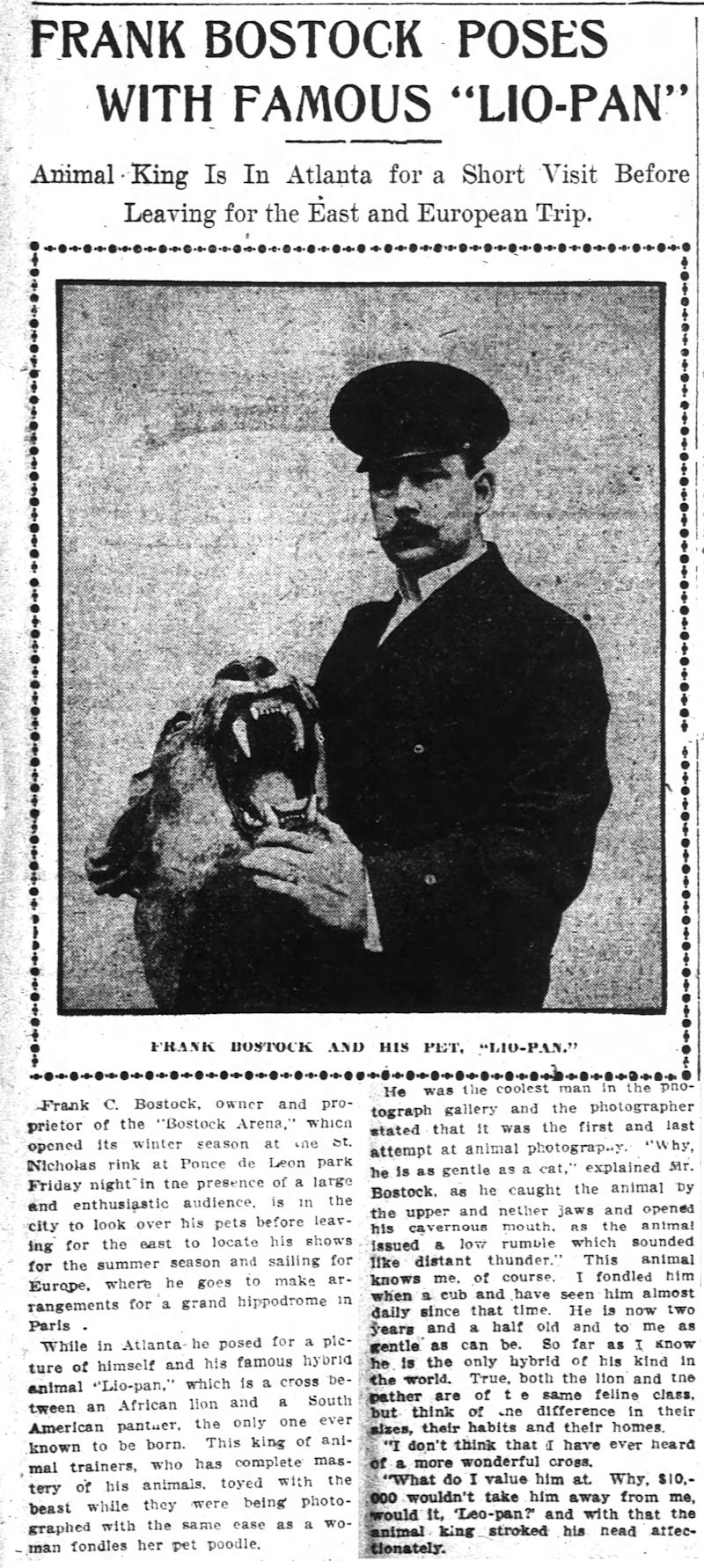
|
HYBRIDS INVOLVING LEOPARDS AND JAGUARS |
JAGLION
A jaglion is a hybrid between male jaguar and lioness. There was a claim of a lion x black jaguar cross (male) seen in the company of an alleged tiger x black jaguar cross (female) in Maui, Hawaii. The supposed lion x black jaguar's description matches that of an African lion. It was described as having a scarred, puffy grey face, short, thick jet black mane on its head and around its neck, extending around the ears and underneath the chin. Its body was solid dark tawny and the tail had a black tuft. The identification of lion x jaguar hybrid was made on facial characteristics. Melanism is a dominant trait in jaguars and its interaction with lion genes was unknown until 2006. The grey face was probably due to poor light. Non-specialists frequently misidentify big cats and erroneously identify them as hybrids. Tigers have never been hybridised with jaguars. The two sighted animals were probably an escaped African lion and lioness.
NEW ANIMAL, THE LIOPAN. New-York Tribune, 27th April 1907, pg 4.
Bostock Has Him and Classifies Him as the Most Ferocious Ever. The leading attraction at the Bostock animal show at Coney Island this season will be a creature that is a cross between a lion and a panther. It has been named liopan. Its head and tail resemble those of the lion, as does its color. But spots of the panther cover it from the neck to the feet. In size the animal resembles the lion, though its long arched back is tat of the panther. In for the liopan’s paws and legs are more like those of the cheetah, only a trifle larger. The trainers of the Bostock show claim that it is the most ferocious animal they have encountered. This has led them to name it Ferocio.

The Atlanta Constitution, November 10th, 1907: FRANK BOSTOCK POSES WITH FAMOUS “LIO-PAN” Frank C. Bostock, owner and proprietor of the “Bostock Arena,” which opened its winter season at The St. Nicholas rink at Ponce de Leon park Friday night in the presence of a large and enthusiastic audience, is m the city to look over his pets before leaving for the east to locate his shows for the summer season and sailing for Europe, where he goes to make arrangements for a grand hippodrome in Paris . While in Atlanta he posed for a picture of himself and his famous hybrid animal "Lio-pan," which is a cross between an African lion and a South American panther [jaguar], the only one ever known to be born. This king of animal trainers, who has complete mastery of his animals, toyed with the beast while they were being photographed with the same ease as a woman fondles her pet poodle.
He was the coolest man in the photograph gallery and the photographer stated that it was the first and last attempt at animal photography. “Why, he is as gentle as a cat," explained Mr. Bostock as he caught the animal by the upper and nether jaws and opened his cavernous mouth, as the anima! Issued a low rumble which sounded like distant thunder. “This animal knows me of course. I fondled him when a cub and have seen him almost daily since that time. He is now two years and a half old and to me as gentle as can be. So far as I Know he is the only hybrid of his kind in the -world. True, both the lion and the panther are of the same feline class, but think of the difference in their sizes, their habits and their homes. I don’t think that 1 have ever heard of a more wonderful cross. What do I value him at? Why, $10,000 wouldn't take him away from me, would it, Leo-pan?” and with that the animal king stroked his head affectionately.
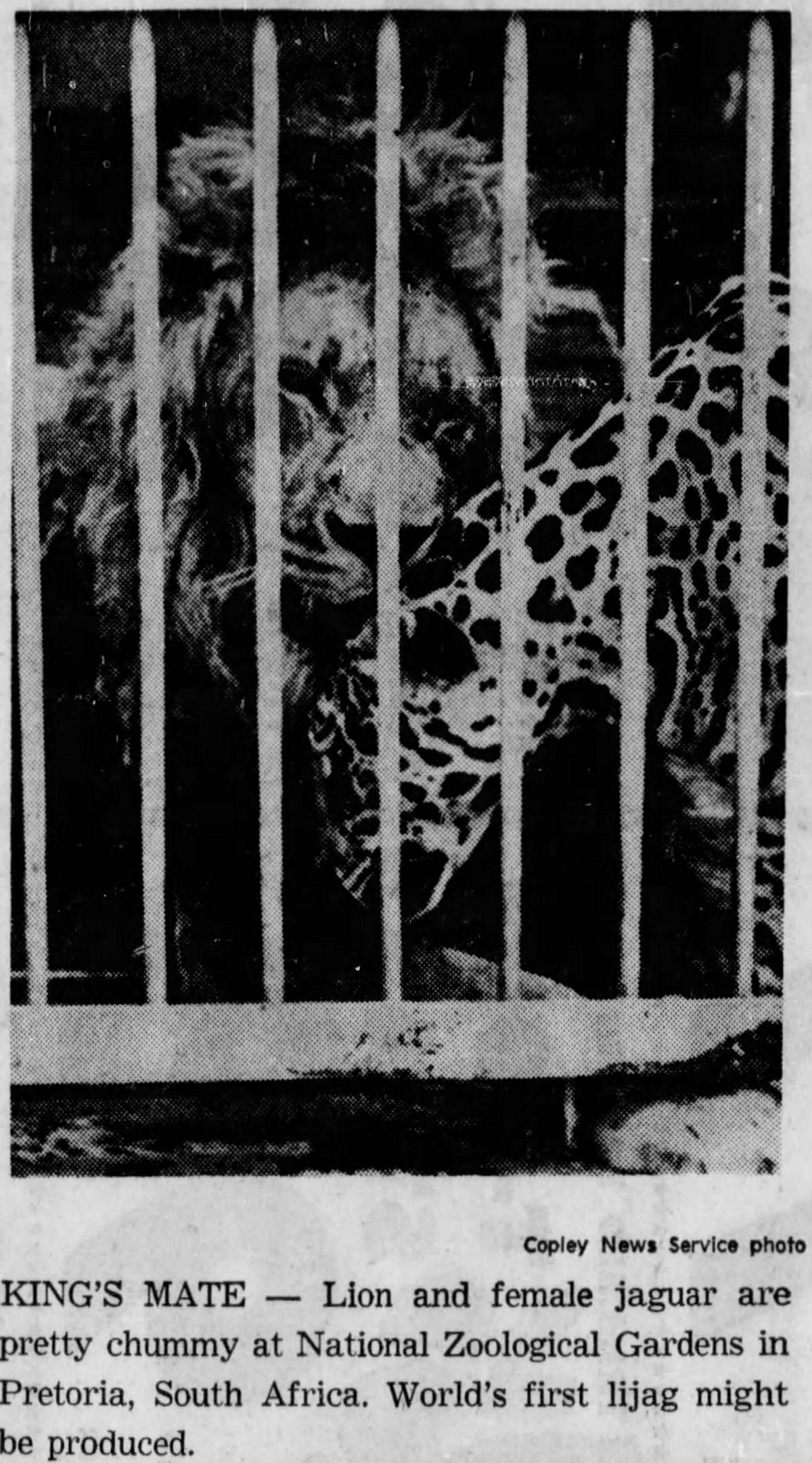
Feb 1967: First Lijag Is Possible: PRETORIA, South Africa - A love affair between an African lion and a South American jaguar might produce the world’s first lijag at the National Zoological Gardens here. Zoo director Dr. D. J. Brand, who is also a world authority on the cat family, placed the full maned lion in a cage with a jaguar and a tigress early in 1965. The lion and the jaguar have mated several times and now zoologists are hoping for results. Lions have proved good crossbreeders in the past but the nearest they have come to the present cross was 16 years ago in the United States when a lion crossed with the offspring of a mating between a leopardess and a jaguar. In 1959 and 1960 at Japan’s Hanshin Zoo a leopard mated with a lioness twice his size and produced a small, maned, spotted male “leopon. Lions have crossed with tigresses on a number of occasions producing “ligers,” anda so have tigers crossed with lionesses to produce “tigrons.” Although offsprings of such matings are usually infertile a “liger” once successfully mated with a lion and produced a female “something or another.”
Known jaglion hybrids have chocolate rosettes on a tawny background colour. The jaguar x lion hybrid below is a preserved individual photographed at the Natural History Museum, Tring, England. The hybrid has the lion's background colour, jaguar-like rosettes and the powerful build of the jaguar. There are no definite records of jaguar/lion hybrids prior to those born at Barrie, Ontario. Since the specimen at Tring matches the description of the lijagulep (Congolese Spotted Lion) it may be that animal. Hemmer was apparently unsure whether the museum specimen he examined was a jaguar/lion hybrid, as stated on the Tring specimen's label, or a leopard/jaguar x lion hybrid. Hemmer (1968) described a mounted specimen as a presumed lion x jaguar or lion x (jaguar x leopard) hybrid, being reddish-yellow, paler than a jaguar, with brown spots. (Photos below)
On April 9, 2006, two Jaglions were born at Bear Creek Wildlife Sanctuary, Barrie (north of Toronto), Ontario following an accidental mating. Jahzara (female,) and Tsunami (male) were the result of a mating between a black male jaguar (Diablo) and a lioness (Lola). The sanctuary does not deliberately breed animals and keepers believed Lola would not conceive. As an added precaution, the pair were separated when Lola came into oestrus. They had been hand-raised together and were inseparable, becoming anxious and depressed every time separation was attempted. Lola pined during attempted separations. Jahzara is melanistic, a dominant trait in jaguars, while Tsunami is spotted. It was not previously known how the jaguar's melanism gene would interact with lion colouration genes. Because female big cat hybrids are frequently fertile, Jahzara could theoretically be bred back to purebred lions to introduce the gene for melanism into that species.
Although displayed as a hybrid of jaguar and lion, the exhibit below is very probably the famous Congolese Spotted Lion, being a 3-way hybrid bred from a jaguar/leopard female mated to a lion.
|
|
|
JAGULEP (JAGLEOP, LEPJAG, LEGUAR)
Crosses of both male jaguar to female leopard and of male leopard to female jaguar have been reported. Combining the size, powerful body and markings of a jaguar and the head of the leopard, the hybrids are more handleable than pure jaguars and are bred for the entertainment industry. Jaguars are apex predators and don’t fear humans, while leopards are smaller and are preyed on by lions so they are more fearful.
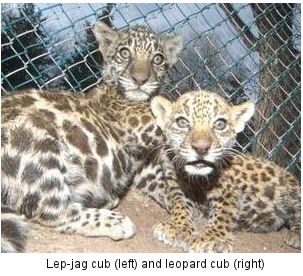
REMARKABLE HYBRIDS. Alexandria Gazette (Virginia), 17th January 1900, pg 1.
There were three addition to the Baltimore Zoo yesterday. Nellie, one of the five female leopards gave birth to three remarkable hybrids. The father of the youngsters is a jaguar, one of those in the collection of Madame Morelli. The event is said to mark the first successful mating of a a leopard and a jaguar in captivity, and the result is very interesting. It has been tried many times in the past, but has, it is claimed, always been unsuccessful heretofore. The attempt to mate a puma and a leopard, or a puma and a jaguar, has also been tried, but has resulted each time in the injury of the puma. The little cubs born yesterday will be exhibited in a few days.
A CENSUS OF THE ZOO. The Indianapolis News, 17th November 1900, pg 20.
A census of the Zoo, in the old Cyclorama rink, in West Market street, brings out soe interesting statistics. People who have not visited this, the latest addition to the amusement institution of Indianapolis, may possibly underestimate both the magnitude and merit of the exhibition Mr. Bostock has opened to the public, and The News has therefore taken a census of the Zoo. Mr. Bostock has brought together in Indianapolis a collection of 289 specimens of the animal kingdom, such as are usually found in menageries and zoological exhibition. [Rare specimens include] the baby jaguar-leopard, which Mr. Bostock claims is the only one of its kind in existence.
[. . . ] Of lions there are fifty-two specimens at the Zoo. Fourteen of these are cubs, and two of the latter ar hybrids born of the tiger Caesar and the lioness Juno . . . three jaguars, two Indian leopards, two American leopards, one jaguar-leopard . . .
New York Tribune, May 16th, 1905 reported “The PRINCE, THE JEALOUS JAGUAR of Mme. Morrelli’s group at Bostock’s Wild Animal Show, Coney Island, died yesterday, and almost simultaneously there came into the world two cubs, born to Nellie II, a leopard. Prince was the father, and these are his only offspring. The babies and mother are doing well. The cubs will be named Prince and Nellie III. They are the only crosses between a jaguar and a leopard ever born in captivity.” The same publication reported on May 28th, 1905: “The business done last Sunday at Frank C. Bostock’s wild animal show, Coney Island, was the largest in his experience as a showman, [. . .]. Another attractive feature has been the two hybrid Jaguar-leopard cubs which were born recently, and of which the lamented jealous jaguar, Prince, was the father. He died the day before the cubs were born. Their eyes are now open. “
In The Field No 2887, April 25th, 1908, Henry Scherren wrote, "Writing in Zoologischer Garten (1903, pp. 288-90), Forstmeister Adolf Rorig, of Frankfort-on-the-Main, gave a summary of the notices of feline hybrids that had previously appeared in that journal. In Barnabo’s menagerie (in Spain) a jaguar threw two cubs to a black panther [leopard]; one resembled the dam, but was somewhat darker, the other was black with the rosettes of the dam showing (Zool. Gart., 1861, 7). The same cross, but with the sexes reversed, was noted by Professor Sacc (?), of Barcelona (Zool. Gart. 1863, 88). The cub, a female, was grey; she is said to have produced two cubs to her sire; one like a jaguar, the other like the dam. Herr Rorig expressed his regret that the account of the two cases last mentioned lacked fullness and precision. [. . .] In a paper on the breeding of the larger Felidae in captivity (P.Z.S., 1861, p140), A.D. Bartlett stated: “I have more than once met with instances of the male jaguar (F. onca) breeding with a female leopard (F. leopardus); these hybrids also were reared recently in Wombwell’s well known travelling collection. I have seen some animals of this kind bred between a male black jaguar and a female Indian leopard; the young partook strongly of the male, being almost black." (It is now known that melanism in the jaguar is semi-dominant, those with one copy of the gene are almost black, while those with 2 copies are fully melanistic)
HYBRID BABIES AT ZOO BEING RAISED ON A MILK BOTTLE. St. Louis Post-Dispatch (Missouri), 21st May 1921, pg 2.
Jaguar Mother of Kittens, Whose Father Was Leopard, Not Assisting With Offspring. Two baby “whatisits” will be on display tomorrow at the Forest Park Zoo. They are the children of Jack the leopard and Kitty the Jaguar. At the age of four weeks they look a good deal like spotted kittens. Whether they will be mostly leopards or mostly jaguars when they grow up is not yet apparent. The main thing is to get them to grow up, In this they are not receiving any assistance from their mother. This is the third family that she has had. She did not like the looks of the other two and killed them. The present pair were taken away from her soon after birth and the kittens are being raised on the bottle and, so far, they are thriving.
JAGUAR’S TWO HYBRID KITTENS BOTTLE FED. St. Louis Post-Dispatch (Missouri), 22nd May 1921, pg 8.
Their Father is a Leopard and They Favour Both Parents – Are Thriving. Beginning today, visitors to the Forest Park Zoo will have opportunity to observe the development of a pair of feline infants that are leopard on their father’s side and jaguar on their mother’s side and are being raised on the bottle. They are four weeks old kittens now, with a family resemblance to both the leopards and the jaguars. What they will be like when they grow up remains to be seen. And what modifying effect bottle nurture may have on them is another uncertain issue. The babies are the product of the mixed marriage of Jack Leopard and Kitty Jaguar. They are being bottle fed because Kitty is so rough with her progeny that they have to be kept away from her. She has had two families before and killed them both. The zoo people fooled her this time. As soon as the kittens began to meow for a meal they were taken away from Kitty and put on the bottle. They took to it very well, and are thriving better than is usual with bottle-fed youngsters at the Zoo. They have been kept in seclusion, but today they will make their bow to the public which may see them extracting sustenance from a bottle if it gets around at meal time.
TWO RARE ANIMALS ARRIVE AT ZOO HERE. Wisconsin State Journal (Madison, Wisconsin), 22nd May 1921, pg 10.
Two interesting and rare young animals arrived last week at Henry Vilas park zoo. Hybrid leopard jaguar cubs were born to the South American jaguar. The children, who have been reproduced in few American zoos, were fathered by the big Indian leopard. They are marked almost like a leopard. The youngsters have not as yet been touched by human hands. Moreover, they will not be touched until they have been weaned by the mother. This is because, for some strange reason, the mother would immediately kill her offspring if they were handled by man.
MOTHERLESS LEOPARD CUBS THRIVE AT VILAS PARK ZOO. The Capital Times (Madison, Wisconsin), 27th October 1922, pg 6.
[Fred Winkleman, director, Wingra park zoo] successfully raised a leopard-jaguar hybrid on a bottle, and the animal, now a year and a half old, is considered one of the finest in the zoo. It is quite tame. [A 1928 census of the zoo’s animals showed the leopard-jaguar hybrid to still be living.]
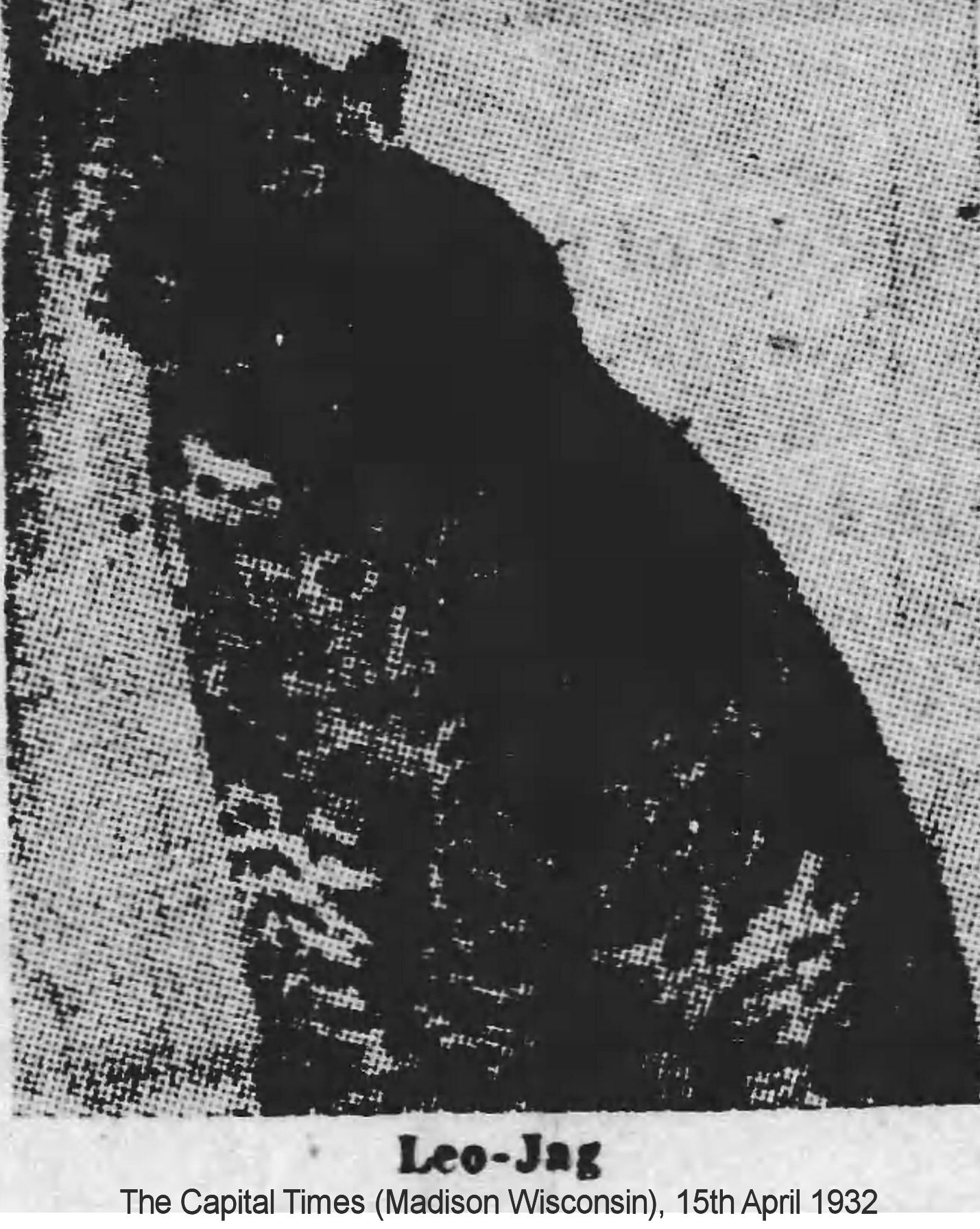
LEO-JAG, LAST OF VILAS ZOO LEOPARDS, DIES THURSDAY. The Capital Times (Madison, Wisconsin), 15th April 1932, pg 1.
Body of Fine Old Specimen Sent to U. for Autopsy. Leo-Jag, the last of the leopards at Vilas park zoo, died Thursday in the cage he had known as home from the time of his birth 12 years ago. Leo-Jag, popularly known as Jack, was not properly a leopard but a hybrid leopard and jaguar, brought up successfully from birth by the Vilas zoo staff to a powerful and handsome specimen. Africa and tropical American strains were combined when Caesar, a magnificent African leopard, and Pocohontas, a tropical American jaguar, were mated and Pocohontas became the mother of the hybrid cub.
During the 12 years of his life, Leo-Jag was a healthy attractive specimen who had not known a day of illness in his life, according to Fred Winkleman, caretake of the zoo. According to the terms of life given to animals bred in captivity, Leo-Jag had lived to a ripe old age. So when early in the week, hemorrhages began, Winkleman knew it was the end. The body has been turned over to the university for an autopsy, and the cage of the leopard is empty. He leaves no sons to follow him, and there is little likelihood that he will be replaced, for the zoo, as well as other Madison institutions, is feeling the depression.
LEOPARD DIES. INSTESTINAL INFECTION CAUSE OF ZOO RESIDENT’S DEATH. The Capital Times (Madison, Wisconsin), 16th April 1932, pg 2 & pg 3.
An intestinal infection caused the death Thursday of Vilas zoo’s last hybrid representative of the leopard and jaguar families. Dr. Walter Sullivan, university professor of anatomy, reported today after a post-mortem examination of the spotted cat. Leo-Jag, as the 12-year-old animal was called, had been in the zoo since birth. He was a cross of the African leopard and tropical American jaguar. Plans for replacing the animal with another leopard or jaguar are not feasible because of the expense, it was said.
[On pg 3:] The pelt will go to one of Leo-Jag’s friends, and the skeleton will be kept at the anatomy laboratory.
LEOPARD TRADE. The Oklahoma News, 4th April 1935, pg 7.
City Zoo Deals for Spotted Animal With a Home-Loving Disposition. Because the stork wouldn’t approach her cage, “Spots,” the female leopard at the Lincoln Park Zoo, is going for a long ride and a change of climate. ”Spots” is a hybrid, her keepers at the zoo told park board members last night – part leopard and part jaguar – and will have nothing to do with her mate even when he slicks up his coat and slinks about with his slinkiest air. So “Spots” is going to Dallas where she will have nothing to do but pace back and forth and spit at little boys who come too close to her cage. [It didn’t mention if her mate was leopard, jaguar or another hybrid.]
Hemmer (1966, 1968) described hybrids from a male jaguar and female leopard as about the size of the jaguar. The neck and legs were rather short and thick. The background colour was dark fawn, grey-brown, iron-grey or olive coloured. The rosettes on the flank were usually much attenuated. Matings of the female jaguar-leopard hybrids to a male jaguar resulted in 2 litters, each with 2 offspring. He noted that a jaguar-leopard also produced an offspring when mated to a male lion (the famous Congolese Spotted Lion hoax).
Sacc (1863) and H Scherren (1908) both reported that a grey-coloured female jaguar-leopard hybrid was mated back to her jaguar father. She produced 2 healthy cubs (jag-lepjags), one resembling the jaguar and one resembling the leopard.
C Pohle (1969) reported a jaguar-leopard hybrid litter comprising 1 female and 2 males. One male died, but at 9 months the surviving hybrids were larger than their leopard mother. At 1.5 years they were intermediate between leopard and jaguar in height at the shoulders. A further jaguar-leopard hybrid was later produced from the same parents.
H Windischbauer (1968) reported a mating of a 6 year old male African leopard (P pardus pardus) with a 2.5 year old female jaguar. Hellbrun Zoo was criticised for the hybrids offered as attractions although these were popular with visitors. Heinrich Windischbauer (director until 1976) was criticized for deliberately breeding the hybrids to attract more visitors to the zoo. If so, he succeeding in attracting the public. The cubs were vigorous and a sign saying “Jagupard” board was placed on their enclosure. The mating, at Hellbrunn Zoo, Salzburg, Austria, produced 2 vigourous cubs in 1966. One cub was smaller in size and darker in colour than the other. At 6 months old, the cubs were both considerably stronger than leopards or jaguars of the same age.
The Long Island Ocelot Club (LIOC) newsletter of Jan/Feb 70 carried a piece by Mary Ellen Tracy who planned to breed jaguar x leopard hybrids. She had a male jaguar called Kwai Mao and a 2 year old Asian leopardess called Takala. She hoped to cross the jaguar and leopard to yield jaguards and test the hybrids for sterility. "We wish to test the differences between these two species to see if perhaps they are not as great as many believe."
The Long Island Ocelot Club (LIOC) newsletter of May/Jun 1976 noted "There are also many black and spotted leopards in [Robert Baudy's] collection, plus a hybrid Lepjag (a cross between a jaguar and a leopard).". In its newsletter for Sept/Oct 1977, LIOC added more information on the hybrid: For six years [Gladys Lewis] has been raising almost all the exotic cats born at Robert Baudy's Rare Feline Breeding Compound in Center Hill, Fla. One interesting aspect of her cat raising methods is the devotion her cats extend to her, even after they leave her. Gladys raised an Indian leopard (male) with a spotted jaguar female from kittenhood in her home, when they matured, not knowing they were from different continents and not the same species, they mated and eventually produced four litters of hybrids called Lep-jag. The first one is now over two years old, Suma by name, and he is still a growing boy at 150 pounds plus. His front end seems to be jaguar, (large head, wide front legs and stocky shoulders) and his rear quarters look like the sleek leopard (long tail).
The Tipton County Tribune (Indiana), 5th August 1980 showed Jungle Larry’s wife, Nancy (“Safari Jane”) with some of the new cubs, including a lepjag. In 1969 the Tetzlaffs had bred “tiglons.” The Pittsburgh Press, 14th August 1980, pg B4 stated “On his Florida spred, his 30-member staff tends to about 200 animals, including three tiglons and a lepjag. Crosses between a tiger and al lion and a leopard and a jaguar, the tiglons and lepjag are bred to be ‘super-intelligent supercats,’ Tetzlaff says.” The Poughkeepsie Journal, 7th December 1980, pg 1C stated “Col. L.E. Tetzlaff (Jungle Larry) has managed to produce an offspring from a leopard and a jaguar, which he calls a ‘lepjag.”
OWNER SORRY ESCAPED BIG CATS SHOT. The Tampa Tribune, 8th October 1987, page 28 (and others). WALDO– A zoo owner who was bitten as two leopard-jaguar hybrids escaped said he was upset that wildlife officers killed the big cats but understood why they did it. “I feel safe with the rest of my animals here,” said Gene Schuler, who with wife, Rusti, runs the 9- year-old Waldo Wild Animal Retirement Village near Gainesville. The cats escaping is just one of those things that happen. I feel bad they had to kill them, but they did what they could,” Schuler said after the female cat was shot Tuesday. "When it started to move and growl at me, my options were out," explained John Duncan, a Florida Game and Fresh Water Fish Commission officer, after tranquilizing efforts failed. The 220-pound male was killed Monday soon after it escaped from the cage it shared with the female. The zoo, which is open to the public, is home to about 80 animals, including lions, tigers, elephants and birds. The Schulers take care of old or unwanted animals. Schuler, 56, was feeding the cats Monday when the male jumped him, wounding his left arm. “I think the male cat bit me because he wanted to get to the chimpanzee cage, and I was in between them. I was really scared for my life, but I knew how to behave in front of the animals in the face of danger,” he said. The cats then escaped from their cage by popping out rotted wood. Schuler was treated for bite wounds and released from Alachua General Hospital in Gainesville. Barry Cook, a supervisor for the State game commission, said Schuler could face charges for allowing the animals to escape, a second-degree misdemeanor punishable by up to six months in jail and a fine of $500.
Lepjags have been kept at Waldo Animal retirement home near Gainesville, Florida and there are still some in captivity in the USA. Lepjags were owned by the magicians Siegfried and Roy. Leopard-jaguar hybrids are more massive than leopards. Their use as animal actors suggests that they are more manageable than purebred jaguars. Current captive lepjags are animal actors that have been retired. Although the term "lepjag" has currency in the USA, a German publication in 1978 refers to the male leopard x female jaguar hybrid as a leguar.
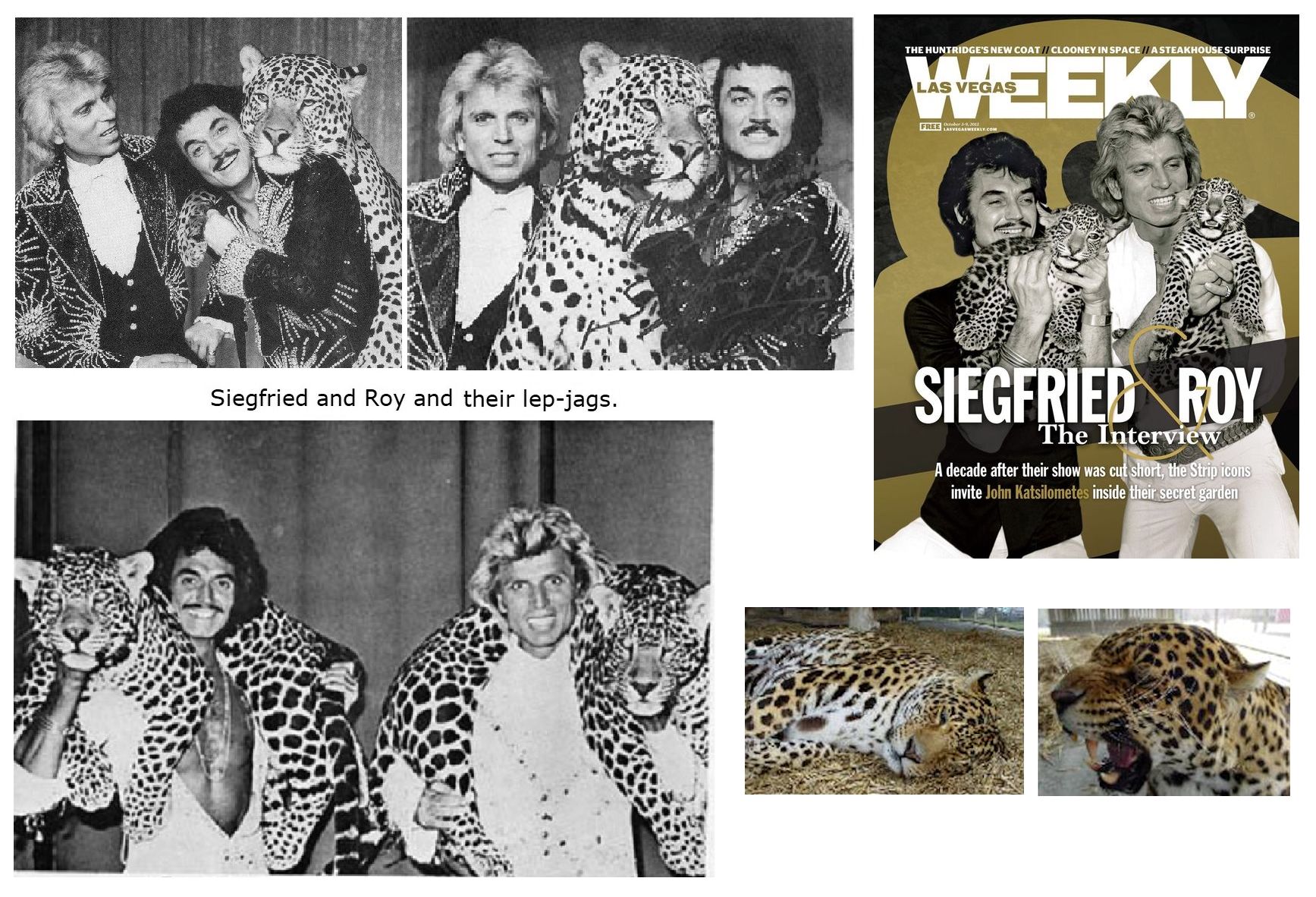
Siegfried and Roy had two spotted lepjags, Ali and Chico, and a black lepjag Sabaka, in their show in the 1990's, and listed them as lepjags in the show's 1994 program. However, in the 1998 souvenir program, they were listed as jaguars. In the book, "Siegfried and Roy - Mastering the Impossible" a photo on page 132 shows Siegfried and Roy in the pool with Ali who is identified on that page as being a lepjag. There is also a picture on page 260 of Siegfried and Roy with one of the lepjags in the show. They used them in the illusion where Roy (or rather a double) and a lepjag were shot out of a cannon; the second spotted lepjag was used to create the illusion. Kevin Chambers saw that show, and could tell right away that the animal that placed in the cannon was not the same as the one on the other side of the stage (where they had been shot to).
Mary Ann Howell and her husband visited the Secret Garden when Chico was on exhibit and were speaking with a security guard when another visitor asked why Chico had jaguar spots on his body, but leopard spots on his neck. The security guard looked at her list of animals, and confirmed that Chico was a lepjag hybrid.
In January 2010, the Serengetti zoological park in Sonora, Mexico, reported a new litter of cubs including a lepjag. They were described by the news as "one jaguar, one panther [leopard], and one jaguar-panther cross".
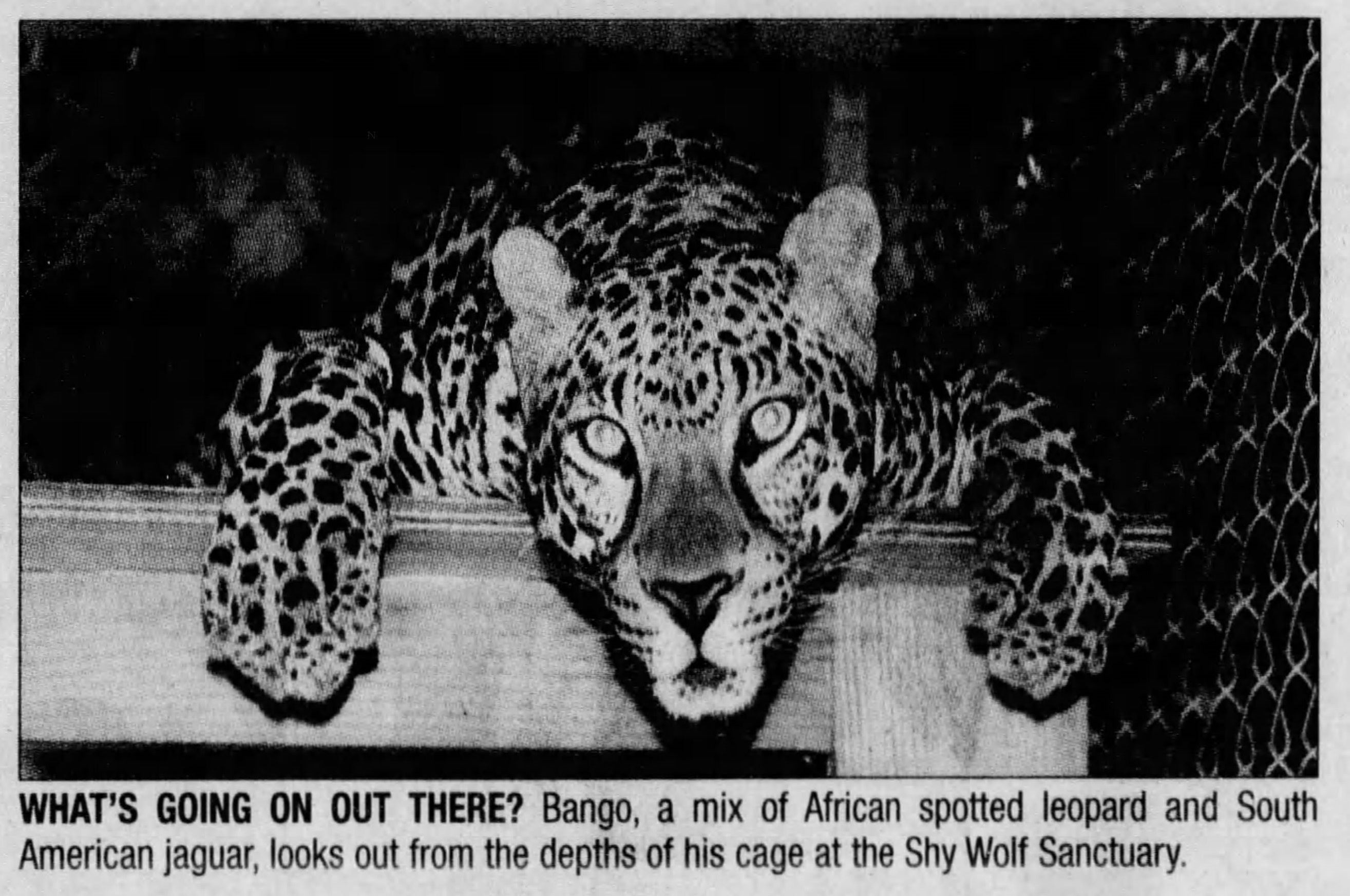
A lepjag called Bango lived at the Shy Wolf Sanctuary in Naples, Florida (exact dates not known, but he was there in 2012). He had an immune disorder similar to sickle cell disease (a possible consequence being a hybrid) and died at the age of 16.
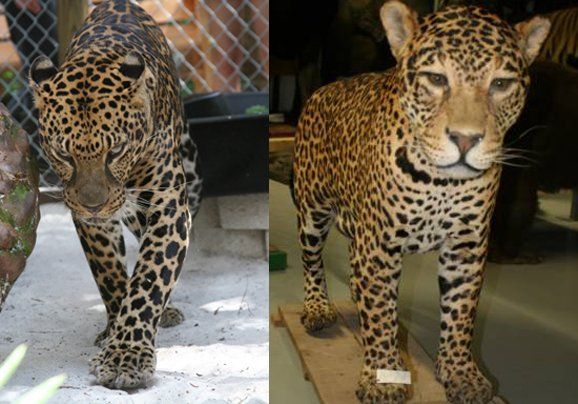
LEONARDO (LEO) the jaguar-leopard cross was bred (2002) in Las Vegas for the entertainment industry and spent his first two years in a Las Vegas show (Southwest Wildlife Center confirmed by email that he did not come from Siegfried and Roy; it is possible he belonged to Dirk Arthur who had a white tiger named Saber, also declawed and with teeth filed down, which went to the Carolina Tiger Rescue). He combined the pattern and powerful size of the jaguar with the head of the leopard. He was declawed on all four paws and defanged to make him safer for his handlers and the audience. Defanging caused him difficulty eating, while the declawing left his feet painful and made walking difficult. After 2 years his owners sold him to a small pet store and zoo in Douglas, Arizona where he spent seven years in a barren 10 x 12-foot enclosure as a curiosity for tourists. He was teased by tourists, neglected by his owners and survived on a very inadequate diet, but because the zoo was registered he could not be confiscated despite substandard accommodation and care. When the zoo fell on hard times, Leonardo was taken by Southwest Wildlife Center. He had a collapsed lung, severe pneumonia and was near death due to neglect and slow starvation. At first, he was scared and angry due to being tormented by humans, but with continuous medical care, a grassy enclosure with ramps, platforms, hiding places and toys and regular treats and positive reinforcement from keepers he became a happy, friendly and playful cat. He was described as a “confirmed bachelor” (male F1 hybrids are sterile, it isn’t mentioned if he was castrated). In 2017 he celebrated his 15th birthday, which is about the average lifespan of leopards and jaguars. By 2019, declining health – exacerbated by years of neglect and incorrect diet - meant failing kidneys and weight loss and he was euthanised.

LIJAGULEP (CONGOLESE SPOTTED LION)
[BI-HYBRIDS] The Rock Island Argus (Rock Island, Illinois), 29th June 1905, pg 6.
Ferari Brothers’ famous trained wild animal arena . . . There are lions, tiger, pumas, panthers [black leopards], jaguars, leopards, hyenas, wolves, hybrids (one-half jaguar, one-half leopard), bi-hybrids (one-quarter jaguar, one-quarter leopard, one-half lion). There are four of these strange animals in the menagerie and they are also in training. These four are said to be the only four animals of their kind that were ever born in the world. Ferari Brothers challenge any show organisation, and will pay a forfeit of $10,000 in cash to anyone that will produce their equal number.
BI-HYBRIDS ARE TREACHEROUS. The Brookly Citizen (Brooklyn, NY), 4th June 1906.
Fear at Ferari’s Animal Show at Brighton Beach the Only One in the World. Colonel Francis Ferari’s bi-hybrids, and he has four of them in his collection of wild beasts at Brighton Beach Park, are the only known living specimens in existence in captivity. They are remarkably savage beasts and were very difficult to train. The Princess Pauline, but a few weeks ago in Toledo at Colonel Ferari’s winter quarters, narrowly escaped death while trying to work them and today carries the marks on her arms, neck and breast of the frightful encounter. [These were either lion x leopard x jaguar mix or lion x tiger x jaguar.]
At times the bi-hybrids give but little trouble, but they are so treacherous that absolutely no dependence can be placed on their seeming quietude. Colonel Ferari values the four animals at $5,000 apiece and has a standing offer of their value, $20,000 to be put up against a like amount, the entire amount to be devoted to any charity, if there is an animal man in the world who can produce their like.
In 1908, a "Congolese Spotted Lion" was exhibited by a showman in London. It turned out to be the offspring of a female leopard/jaguar cross which was then crossed with a lion. It had been bred at Lincoln Park Zoo, Chicago, America (not Brookfield Zoo as this didn't open until 1934) and exported as a public attraction. The "manufacture" of supposedly exotic cats was once big business and exotic or freakish big cats were exhibited to the public with some story about them being a newly discovered animal. According to "Wild Cats Of The World" by Guggisberg, "Around the turn of the century three cubs were born at a Chicago zoo from a male jaguar and a female leopard. They were sold to a traveling menagerie and the male was killed by a lion, while the females grew to jaguar size. They were mated to a lion, which they seemed to prefer to a leopard, and produced several litters. One of these jaguar-leopard-lions came to London Zoo. The animal looked like a young, slim lioness but was marked with brown spots of a jaguar- or leopard-like pattern.". Guggisberg cites Pocock, R.I. 1908 "Hybrid Lion and Leopard" and The Field, April 18; Pocock, R.I. 1908 "The Supposed Lion and Leopard Hybrid." Others described it as being "the size of a lioness, but scrawny, with brown spots of either the jaguar or leopard variety."
|
|
"A HYBRID CAT. Special Dispatch to The Inter Ocean TOLEDO. Ohio, April 29 [1906].—With her right breast nearly torn from her body, an artery In the left arm severed, and the hand chewed almost to a pulp. “Princess Pauline," an animal trainer, lies at the point of death as the result of a savage attack of a lion hybrid cat. The beast, which is a cross between a lion, leopard. and jaguar, was being caged after a day’s training in the pit when it sprang upon the “Princess” without warning. As she fell she knocked a wooden bench between herself and the beast, and this saved her from almost instant death. One paw of the beast tore off her breast, another tore her face, while the left arm was badly bitten. After a terrific fight Head Trainer MacPherson and Colonel Ferari drove the beast away with bot iron pikes. The woman has but a slight chance of recovery.” Luckily she did recover and she continued to work with big cats.
ANIMALS ATTACK TRAINERS. BI-HYBRID ATTACKS WOMAN. The Brooklyn Citizen, 6th June 1906, pg 7.
The Princess Pauline was in the arena with her mixed group, consisting of two bi-hybrids, two jaguars and three pumas. The bi-hybrids had been acting very badly; the larger of the pair refusing absolutely to work, and climbing to the top of the cage out of reach of her prong, the only thing an animal really fears in the hands of its trainer. [Pauline was then mauled by a jaguar.]
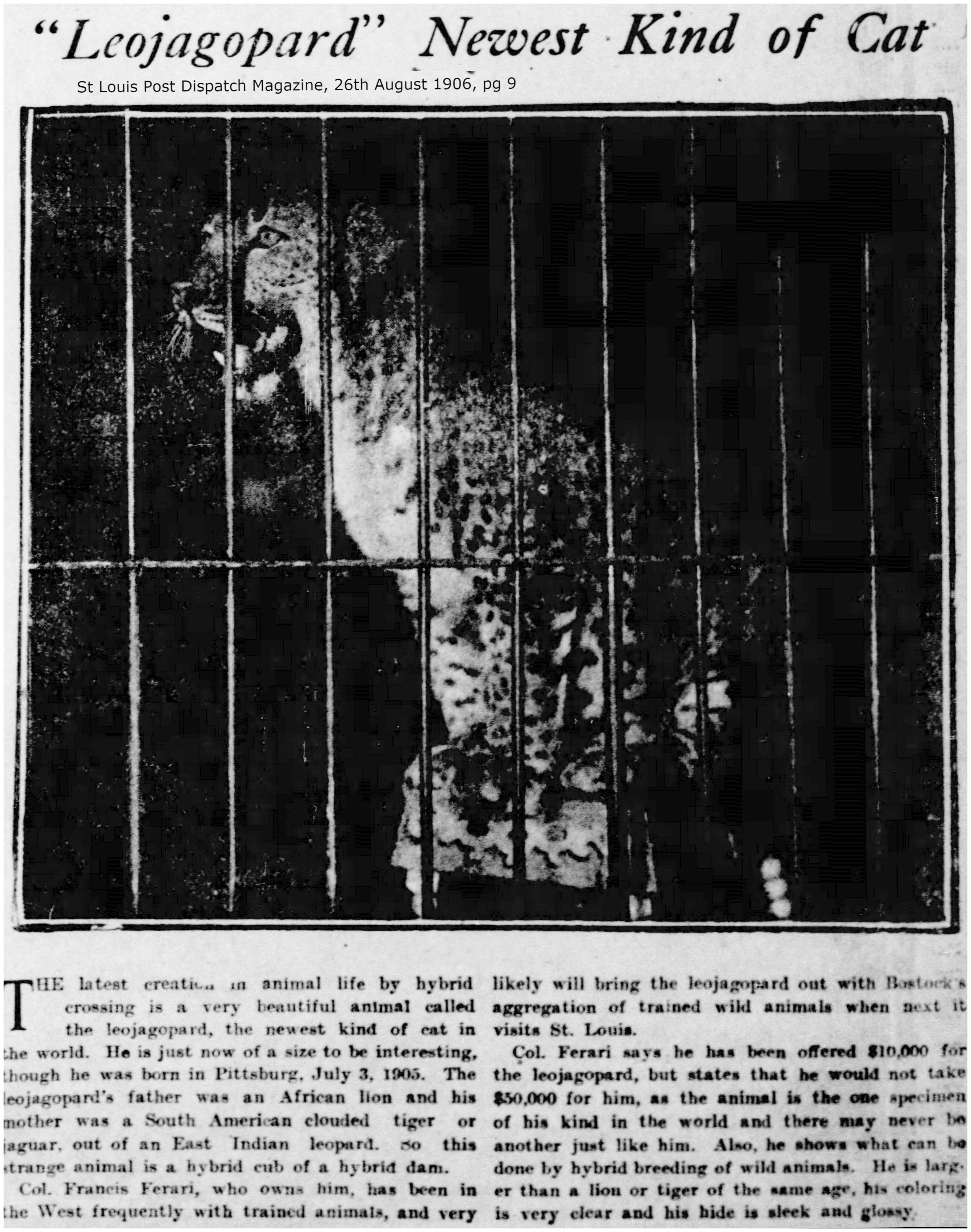
From The New York Times of June 4th, 1906, we have this item that says four lion-leopard-jaguar hybrids had been born. “ALL HYBRIDS AT CONEY. Some Beasts There Are Bi-Hybrids This Year — All Are Mighty Rare. Bulletin chased bulletin out of the animal shows at Coney Island yesterday. A Coney Island animal show is a cheap affair this year if it hasn’t at least one hybrid; naturally the press agents aren't forgetting that fact. CoL Francis Ferrari has a collection of; wild beasts at Brighton Beach Park. Four of his pets he called bi-hybrids. Their father is a full-bred native African lion and the mother, it is asserted, is a cross between a jaguar and a leopard. The four youngsters are described as the most peevish little rascals that were ever in captivity. Col. Ferrari gave zest to the day's news by declaring yesterday that he would give $20,000 if any animal man could produce their like. Following this offer. Bostock’s press agent announced, with tears in his voiced that “Tricolor,” the Bostock hybrid, had just died. At the same time, however, there were born to the lioness Princess two tiny cubes Their father is said to be a cross between a puma and “the famous self-eating Jaguar whose favourite occupation is biting a section of his own tail off.” Tricolor was only a cross of a puma, a jaguar, and a lion. That, the press agent says, is quite a common cross. The new cubs, of course, are very rare.”
BIG ANIMAL SHOW FOR STATE FAIR. The Times Dispatch (Richmond, Virginia), 8th August 1906, pg 10.
Colonel Fred Lewis, wild animal show manager, and all round amusement man, is in Richmond negotiating for a long stay here this fall and winter . . . Among the attractions which the Colonel proposes bringing here in connection with the wild animal shows are the following: six bi-hybrids, the only animals of their kind in existence. These animals are one-quarter leopard, one-quarter jaguar and one-half lion, combining all the ferocity, craftiness and vicious untamable nature of each of these animals. These queer animals are put through a course of stunts by Madame Charlotta DeVere.
“LEOJAGOPARD” NEWEST KIND OF CAT. St. Louis Post-Dispatch (Missouri), 26th August 1906, pg 49
The latest creation in animal life by hybrid crossing is a very beautiful animal called the leopjagopard, the newest kind of cat in the world. He is just now of a size to be interesting, though he was born in Pittsburg, July 3, 1905. The leojagopard’s father was an African lion and his mother was a South American clouded tiger or jaguar, out of an East Indian leopard, so this strange animal is a hybrid cub of a hybrid dam.
Col, Francis Ferari, who owns him, has been in the West frequently with trained animals, and very likely will bring the leojagopard out with Bostock’s aggregation of trained wild animals when next it visits St. Louis. Col. Ferari says he has been offered $10,000 for the leojagopard, but states that he would not take $50,000 for him, as the animal is the one specimen of his kind in the world and there may never be another like him. Also he shows what can be done by hybrid breeding of wild animals. He is larger than a lion or tiger of the same age, his colouring is very clear and his hide is sleek and glossy.
FIVE YORK FAIR BABIES. The York Dispatch (York, Pennsylvania), 1st October 1906, pg2.
Five tiny hybrids, the first of their kind ever born, came to the cage of a handsome female panther Julia Saturday evening. They are a rare cross between the panther and Francis, a great jaguar. The cubs are no larger than kittens, but already bear the beautiful marks of their royal father. The panther is what the showmen call a good mother, this because she has not yet had an appetite for any of them. The are being carefully guarded, as if they are raised they will be of great value.
Ferari’s success in mingling the breeds of the wild animals in his big collection is demonstrated in three of the most beautiful of the cat tribe ever seen. They are called bi-hybrids. The female offspring of a female leopard and male jaguar was bred to a lion. The result, which it is claimed the great Haganback [Hagenbeck] has vainly tried for is a handsome animal with the build of a great panther. The three one-year olds with the show are of a golden shade with the beautiful leopard spots showing faintly. Mayor McCall is to be asked to christen the five babies.
BRINGS BIHYBRID AS GIFT. The Baltimore Sun (Maryland), 19th December, 1907, pg 10.
Colonel Ferari Remembers Colonel Mundy – Rare Feline Has Cold. Col, Francis Ferari arrived in Baltimore late last night for a short while to Colonel Mundy, of the Zoo, as well as to many other friends here. Colonel Ferari, besides being one of the most popular showmen in American, is best remembered by visitors to the Jamestown Exposition who witnessed his superb animal show there. The Colonel brought with him a 1-year-old bihybrid of the feline species and presented it to Colonel Mundy. It is said that this is the only animal of its kind in captivity. Colonel Mundy believes it has already contracted a serious cold, due to the sudden changes of climate. The offspring of a leopard and a tiger or jaguar is commonly called a hybrid, and the offspring of a hybrid and a leopard or tiger or jaguar is called a bihybrid.
CHEWED UP BY A WILD BEAST. The Baltimore Sun (Maryland), 17th April 1909, pg 2.
Tony Bartlett Severely Mangled in Presence of 2,000 Persons. Norfolk, Va., April 16. Tony Bartlett, a young lion trainer attached to the Ferari’s Animal Sow, was attacked here last night before 2,000 people by a bi-hybrid animal and came near being torn to pieces. He was in a cage with that animal, which is of a cross blood of the lion, tiger, leopard and jaguar, and three lions, when the bi-hybrid sprang upon him and knocked him to the floor. Taking his right leg between its jaws I had almost bitten it off when Colonel ferari entered the cage with an iron rod in each hand. With one rod he overawed the three lions and with the other pounded the bi-hybrid until it ceased its attack on Bartlett. The people were panic stricken and stampeded. Several ladies fainted.
EAGLES TO GIVE CARNIVAL. The Washington Herald (Washington, D.C.), 2nd May 1909, pg 4.
“Queenie,” a vicious bi-hybrid, during a performance at Norfolk two weeks ago attacked and terribly lacerated her keeper, Tony Bartlett, and only the quickness of Col. Ferari himself averted his death . . . “Queenie” is one of the few hybrids in existence, and is not bred for trick work or to be trained, It is said that nobody but Col. Ferari would undertake such a task, and that “Queenie” is the only one that is being broken in.
“EAGLES” OPEN BIG CARNIVAL. Evening Star (Washington, D.C.), 4th May 1909, pg 8.
LaBelle Salicia danced with a lion, while Mlle. Marcella placed in subjection a snarling pack of lions, jaguar, leopards, tigers and bi-hybrids, the latter being one-half lion, one-quarter leopard and one-quarter jaguar . . . More lions and bi-hybrids appeared when Capt. Bartlett was introduced.
[LION-LEOPARD-JAGUAR BI-HYBRIDS] Staunton Spectator and Vindicator (Staunton, Virginia), 14th May 1909, Pg 3.
Two baby bi-hybrids were added to Col. Ferrari’s trained animal show of Washington, D.C. The mother, Maxine, is one of the largest, if not quite the largest, bi-hybrid in existence. She is only partly trained, and is such a vicious animal that it is not likely she will ever be entirely trained to do the work now being done by her brother and sister bi-hybrids. These peculiar animals are a cross-breed, being half lion, one quarter leopard and one quarter jaguar. Unlike any other animals, wild or otherwise, they at their young, so that it was necessary to remove the babies as soon as they were born. The mother made such an outcry for them and behaved so wildly that she caused all the other animals to become exceedingly excited, and they reared and plunged about for hours before peace finally settled down over the menagerie. The little arrivals are not at all pretty, but they are interesting in their being such a novelty. They greatly resemble new-born kittens, except that they are much larger.
“AFRICA” AT GIMBELS. FINE COLLECTION OF JUNGLE ANIMALS ON EXHIBITION AT DEPARTMENT STORE. The Philadelphia Enquirer, 20th November 1909, pg 9.
Included in the array of animal talent . . . there are also bi-hybrids, which are quarter Jagua, quarter leopard, and half lion. [These were Ferari’s animals].
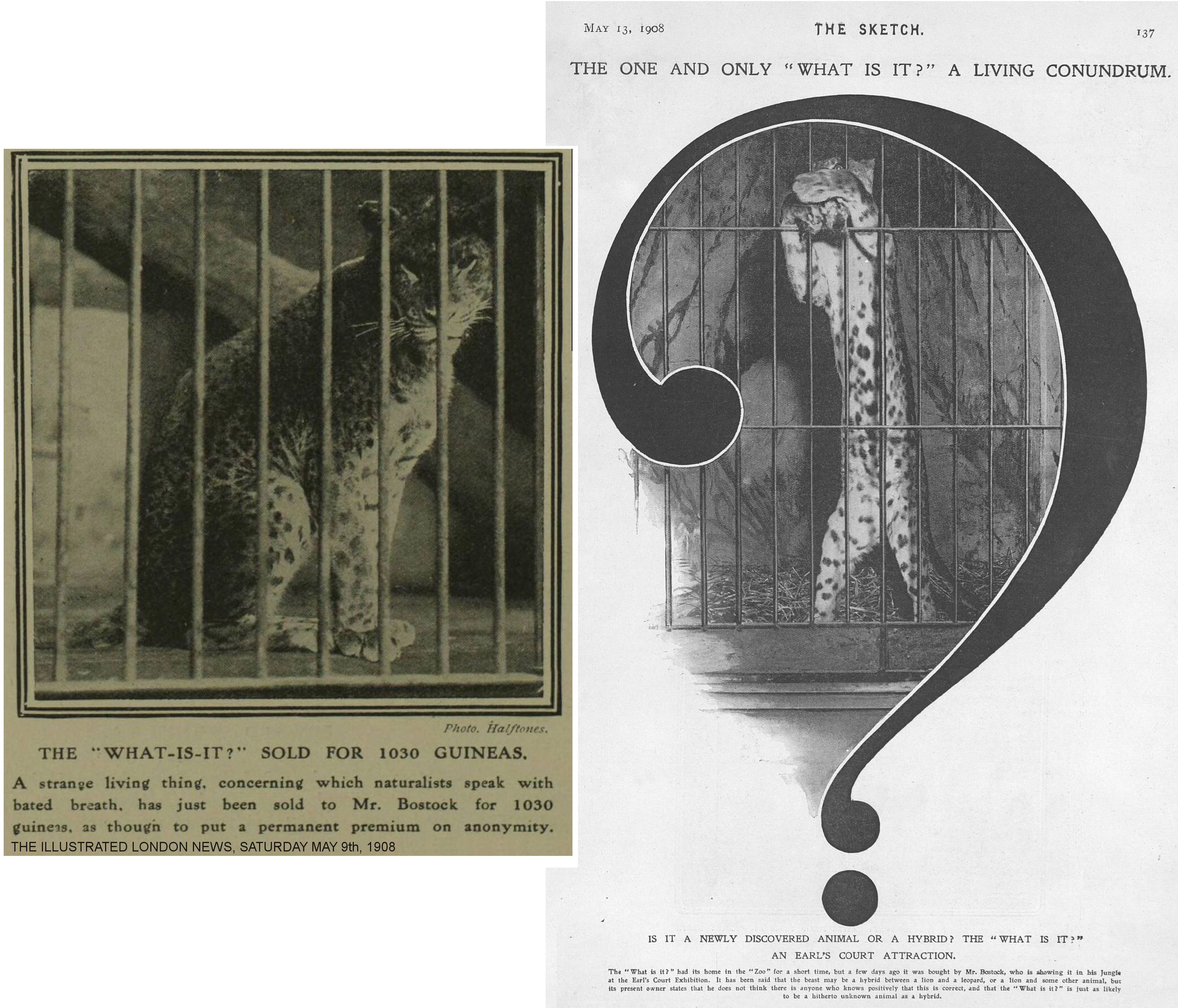
The Times (April 15, 1908) pg. 6 stated "A STRANGE ANIMAL FROM THE CONGO: Mr J.D. Hamlyn, the animal dealer of St. George-street, E,, who has just obtained two or three new monkeys from the Congo, has just received from the same region a very curious feline animal nearly as large as an adult lioness, which it resembles in build, but irregularly spotted. There is no trace of a mane or ruff, nor is the tail tufted as in the lion. The general body hue is tawny, but with a rufous tinge, reminding one of the coat of the cheetah rather than the leopard, and the inner sides of the limbs are yellowish-white, with dark spots. The markings on the upper surface differ greatly in size and character; on the hind limbs they are large; towards the forequarters and head they diminish in size, but increase greatly in number, and the face is, so to speak, stippled with black except on the nose. There is a black mark on each side of the lower jaw, and a black striped on the posterior of each ear; and along the spine, from the root of the tail to about the centre of the back is a row of dark markings, somewhat like disconnected links of a chain. The hue of the tail for the greater part of its length corresponds to that of the body, but the terminal portion is banded witg black and white. The animal, a female, is in excellent condition and fairly quiet. The obvious suggestion is that the animal is a wild-bred hybrid, with a lioness for dam and a spotted cat for sire. Lion-tiger hybrids were bred in this country in the early part of last century by Atkins, the proprietor of a famous travelling menagerie; among Continental breeders Carl Hagenbeck has been most successful. A cross between the puma and leopard has also been obtained, but wild-bred hybrids between the larger cats are exceedingly rare. To-day the animal will be sent to the Zoological Gardens, where the question of its parentage will be scientifically investigated."
The same animal was widely reported in the British press. Here is a report from the Belfast Weekly News, 23rd April, 1908: STRANGE BEAST OF PREY. Once more Africa has yielded something new and exceedingly strange. Mr. J, D. Hamlyn, the well-known animal dealer, of St. George Street East, has received from a correspondent on the Congo one of the most extraordinary feline animals over seen. It has been said that it is a new species, with affinities to the lion on the one side and to the leopard on the other. Against this view, says the “Standard,'’ must be set the fact that this appears be the only individual of the kind ever met with, and it is exceedingly doubtful if a new species would have escaped observation for long. A much more probable view is that which regards it a wild-bred hybrid between a lioness and one of the large spotted cats. In its travelling box in Mr. Hamlyn’s yard the animal, a female, could scarcely be seen to advantage. When viewed directly from the front, the head distinctly recalled that of lioness, hut when seen from the side the spots, arranged like those of no known species, at once attracted attention. In size she may be compared to a nearly full-grown lioness, with a rufous tinge on the coat, more like the hue the cheetah than that of the leopard. On the hind quarters the spots are large, and diminish in size towards the forequarters, and on the face, with the exception of the nose, there is a thick crop of small dark marks. The under-surface is whitish, also marked with dark spots. The tail is not tufted, as in the lion; for the greater part of its length it is of the body colour, with indistinct blotches, and the terminal portion is banded with black and white. Something has been said about this being a spotted lion, but the markings of this animal differ entirely from the spots of immaturity that are sometimes retained, especially by females, for a period. This curious feline will be removed to the Zoological Gardens, London, where it will no doubt attract a large number of visitors.
RI Pocock's letter to The Field (April 18th, 1908): "Sir - Since the days of Linnaeus and Schreber no large member of the cat tribe (Felis) alleged to have been caught or killed in the wild state has been imported into Europe which could not be at once assigned to one or other of the following six forms: lion, tiger, jaguar, leopard, ounce, or puma. Each of these represents a well-marked, easily recognisable type, and, despite their subdivision into numerous local races, every schoolboy can tell the main species apart without reference to geographical distribution. Of exceptional interest, therefore, is it to record that on Saturday last, the Zoological Society was informed that Mr Hamlyn, the well-known dealer in the east of London, had procured a large cat, exceeding a leopard in size, which he could not identify with any of the species just mentioned. Examination of the animal, which is now on exhibition in the lion house in the Zoological Gardens, fully justifies Mr Hamlyn's perplexity.
A superficial glance suggests that she is a hybrid between a lion and a leopard. She is larger than a leopard, and, although certainly adult, much smaller than a full-grown lioness. She stands about 30in at the shoulder, and is lank and long-limbed, approaching in build a lean lioness rather than a leopard, and resembling also the former rather than the latter in the shape of the head. The ground colour is tawny, becoming richer in tone in the posterior than in the anterior part of the body. On the throat and underside the tawny colour gradually fades into white. The whole animal is spotted like a leopard, but the spots are brown, not black, with the exception of some of the solid spots low down on the hind legs and on the belly. On the sacral region the spots are also nearly black, elongated, and arranged in longitudinal lines, and on the sides of the body they form rosettes as large as those of some jaguars, with slightly darker centres, containing smaller isolated spots. The tail is very remarkable. It is as long as is a leopard, and exceeds that of lion, the end being upcurved to keep clear of the ground. For the greater part of its length it is very short-haired and very faintly spotted, but the terminal 6in are longer haired, black-spotted, whitish beneath, and black, but not tufted at the tip. In short the distal end of the tail is like that of a leopard, and the proximal portion like that of a lion. Another leopard-like feature is the presence of a patch of black hair round the corner of the mouth, and of a transverse black stripe across the throat.
It appears to me that two, and only two, opinions can be held about this animal. She is either a lion-leopard hybrid or an example of a new species standing midway between these two species. I strongly incline to the former hypothesis, which would need no justification were the history of this animal known. The disparity in size between a large male leopard and a small lioness that had just reached maturity would not necessarily be an obstacle to pairing, and since it is known that lions and tigers on the one hand, and leopards and pumas on the other, have been successfully crossed in captivity, there is no reason for thinking that leopards and lions should not also be cross-bred; for, as I have recently pointed out, the relationship between leopards and lions is much closer than that between leopards and pumas, lions being in all probability directly descended from some species of Felis closely akin to leopards and jaguars, as is attested by the patter of the cubs, as well as by other points of resemblance. But the history of this animal cannot be squared with the supposition that she is a menagerie-bred hybrid, unless - which is hardly likely - she was bred by natives or traders in West Africa. According to the story told to Mr Hamlyn, she was brought as a cub by natives to a French trading settlement somewhere up-country from the Gaboon, and was kept in captivity for about two years before being transported to the west coast and shipped to Europe this spring in a French boat.
Now leopards, although apparently not common in the French Congo, seem to be almost ubiquitous in the forest region of West Africa. Lions, on the other hand, are unknown in the southern portions of that territory, although they have been recorded from its northern districts up towards Lake Chad. It is possible, therefore, that a hybrid between the two species may have been produced without human intervention in the northern area of French Congoland. This, however, seems highly improbably, for lions habitually frequent open, scrubby country, while leopards are essentially forest dwellers, and even if representatives of the two species were to meet, the encounter would more likely end in the death of the leopard that in the establishment of friendly relations between them. In addition to these objections must be urged the total absence up to the present time of records of the occurrence of natural hybrids, or of specimens suggesting in the remotest degree that they might be hybrids, between any two of the known wild species of Felis.
Against the hypothesis that the animal, which is certainly not a leopardess, and equally certainly not a lioness with retained cub spots, represents a large undescribed species of the cat tribe there is nothing to be urged beyond the circumstance that the existence of such a creature has never been hinted at or suspected, although good collections of the fauna of the country whence it is alleged to have come have reached the Paris and European museums. Possibly such a form may have been overlooked, but until the history of this specimen, as told to Mr Hamlyn by its original owner, has been verified it would be rash to regard it as an example of a genuine wild species. All that can be done at present is to urge naturalists and sportsmen who visit the French Congo in the future to keep a sharp lookout for a second specimen of this most interesting beast."
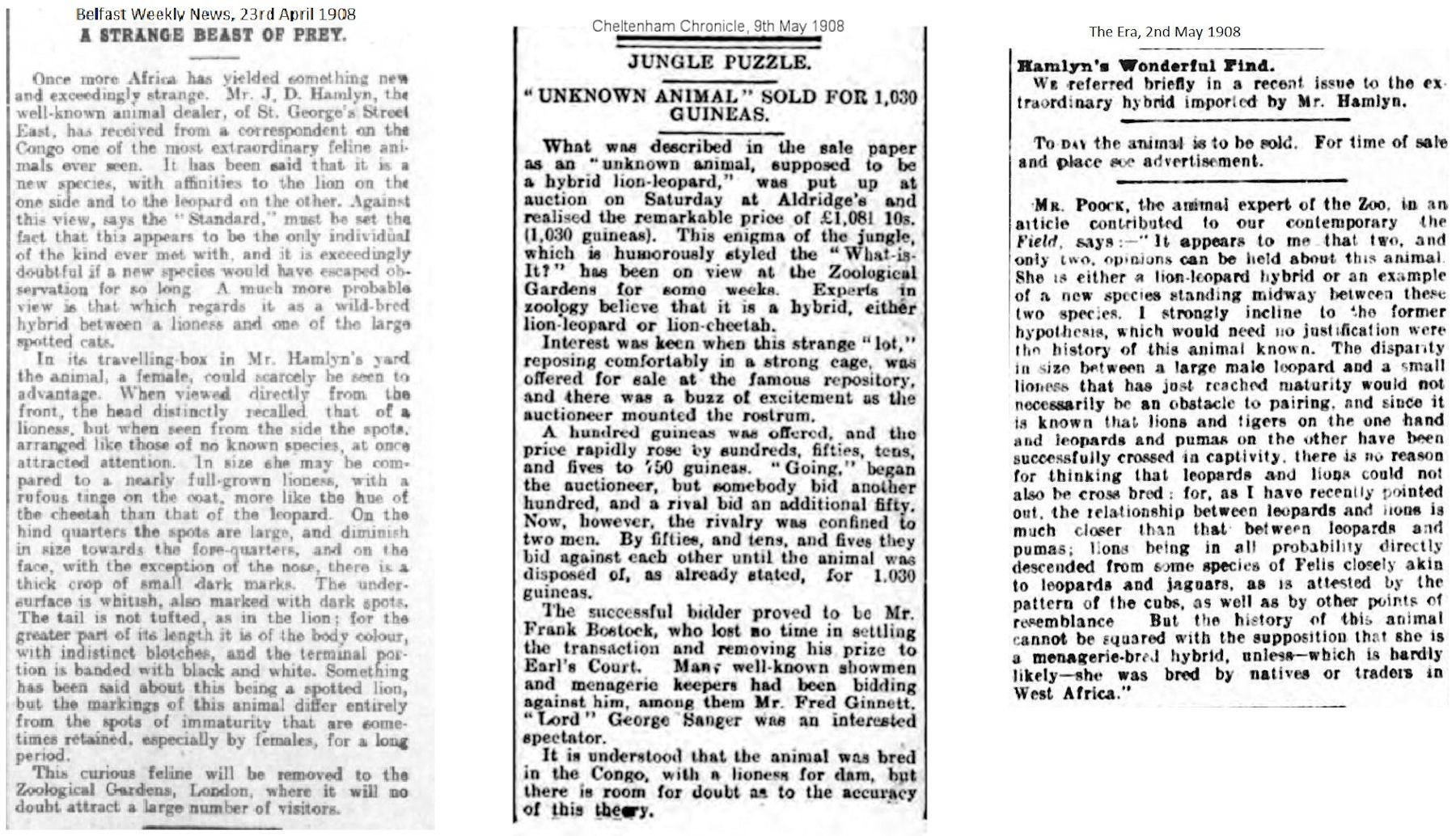
In The Field No 2887, April 25th, 1908, the editor wrote "An illustration reproduced from a drawing by Mr F W Frohawk, of the supposed lion-leopard at the Zoological Gardens is now presented, and it will be interesting to compare it with the picture which accompanies the letter on feline hybrids by Mr Scherren. Mr R I Pocock's remarks on this interesting animal which appeared in last week's "Field" leave little more to be said at present. It would certainly appear to be either a hybrid lion-leopard, or else a new species of large leopard, a supposition strengthened by several points of closer resemblance to a leopard that to a lion, and the pattern of the larger rosette markings which are like those of the snow leopard (Felis uncia). It may be well to note in further detail the colouring and markings of the beast. The ground colour is a pale tawny-buff, blending into creamy-white on the undersurface of the body; chin, throat, chest, inside of legs and undersurface of end of tail whitel; the whole surface of the body and legs is spotted similar or a leopard and snow leopard, the head and neck being less plainly marked; all the markings on the upper parts are pale, dusky, developing into black below, and deep black on both surfaces of the legs. An important feature is the pattern of the larger rosette markings, which are similar to those of the snow leopard, being composed of smaller spots, but forming larger rosettes than is usual in the ordinary leopard. Excepting the crown, the spots on the head, and especially on the neck, are small, and more or less indistinct. The fore paws, rump and basal three-fourths of the tailare much like those of a lioness in form, but the end of the tail, although less ample, is marked like a show leopard's. The black angle of the nmouth is similar to that of a leopard; the nose is dull-pink and eyes pale ochreous, like most leopards; but the general squareness of the head and rather large ears are more lion like. At times, when the animal is standing slackly, she is hollow backed, but usually the back is as shown in the drawing. That idea that this animal may possibly prove to be a new species of great cat will not be generally entertained; but it must be remembered that a far more conspicuous creature, to wit, the okapi, has only been made known to us of late years, and that it is possible that such an animal as that now in question frequenting, as it would undoubtedly do, dense forest regions, and being of nocturnal habits, might have escaped observation."
The possibility was considered that the Congolese spotted lion may have been part cheetah or a new species of leopard. In The Field No 2887, April 25th, 1908, Henry Scherren wrote "In all probability the interesting animal now in the lion house of the Zoological Gardens is the only feline hybrid yet exhibited for which the claim has been advanced that it was wild bred. The story of its origin as told to Mr Hamlyn, and given by Mr Pocock in his letter,is of considerable interest; but, in my opinion, the interest will be heightened when the gentleman by whom the animal was consigned to Mr Hamlyn gives us full particulars. On the view that this animal was bred in the Congo, with a lioness for dam, there could have been but two possible sires: the leopard or the cheetah. Mr Pocock has given his reasons for accepting the former, but I think he will admit that there is a superficial resemblance to the latter. Conclusive evidence against the supposition that a cheetah had any share in the parentage - tough it occurred to me when I first saw the animal in her travelling box - is afforded by the size of the head, the massive forelimbs, and the retractile claws.
Certain difficulties, however, present themselves with regard to the story that the animal was wild bred. One was pointed out by Mr Pocock in hias remark that 'if representatives of the two species were to meet the encounter would be more likely to end in the death of the leopard than in the establishment of friendly relations between them.' next I cannot equate the apearance of the animal in regard to age and development with the scanty details that have been given to Mr Hamlyn. Granting that it was even two years old when brought by the natives to the French trading settlement, the two years spent in confinement in Africa and the time occupied in the passage to Europe do not, in my opinion, account for the whole span of its existence. And from what I saw of the hybrid before she was unpacked, and afterwards in one of the spacious dens in the lion house, I should have come to the conclusion that she was well used to being exhibited but for the assurance from Mr Hamlyn that this was not the case. Everybody who has seen the animal will agree with Mr Pocock that it is of the highest interest, and it is to be hoped that it will remain in its present quarters." The markings on the Congolese spotted lion in Frohawk's illustration (The Field No 2887, April 25th, 1908) exactly match those on the museum specimen.
An article from The Times for Monday May 4, 1908 pg. 12 said "Sale Of A Supposed Congo Hybrid. After having been on view in the lion house at the Zoological Garden for about a fortnight the feline hybrid described in The Times of April 15 was sold by auction at Aldridge's on Saturday. The attendance was very large; among those present were a good many showmen. Bidding began at 100 guineas, and eventually the animal was knocked down by Mr. Bostock at 1,030 guineas. One of the conditions of sale appears somewhat strange for it disclaimed any guarantee as to the animal's breeding, age, or any other description. This would seem to show that the story of the animal, as told to Mr. Hamlyn by the original owner, has not been verified. The story was that the hybrid had been brought as a cub by natives to a French trading settlement somewhere up country from the Gaboon, and kept in captivity for about two years before being transported to the West Coast and shipped to Europe in a french boat. At any rate the responsible officials at the Zoological Society do not appear to have been convinced by the story, or they would probably have made some offer for the animal, for which about 500 pounds was asked a fortnight ago. The keepers in the lion house maintain a strong opinion that it was bred in a menagerie; the responsible officials are more reticent on the subject and prefer to wait for evidence as to the place of birth, and the species from which the creature was bred."
JUNGLE PUZZLE. “UNKNOWN ANIMAL” SOLD FOR 1,030 GUINEAS. (Cheltenham Chronicle, 9th May, 1908). ”What was described in the sale paper as an "unknown animal, supposed to be a hybrid lion-leopard,” was put up at auction on Saturday at Aldridge's and realised the remarkable price of £1,061 10s. (1,030 guineas). This enigma of the jungle, which is humorously styled the “What-is- It?” has been on view at the Zoological Gardens for some weeks. Experts in zoology believe that it is a hybrid, either lion-leopard or lion-cheetah. Interest was keen when this strange “lot,” reposing comfortably in a strong cage, was offered for sale at the famous repository, and there was a buzz of excitement as the auctioneer mounted the rostrum. A hundred guineas was offered, and the price rapidly rose by hundreds, fifties, tens, and fives to 750 guineas. ‘Going,’ began the auctioneer, but somebody bid another hundred, and a rival bid an additional fifty. Now, however, the rivalry was confined to two men. By fifties, and tens, and fives they bid against each other until the animal was disposed of, as already stated, for 1,030 guineas. The successful bidder proved to be Mr. Frank Bostock, who lost no time in settling the transaction and removing his prize to Earl's Court. Many well known showmen and menagerie keepers had been bidding against him, among them Mr. Fred Ginnett. ‘Lord’ George Sanger was an interested spectator. It is understood that the animal was bred in the Congo, with a lioness for dam, but there is room for doubt a« to the accuracy of this theory.”
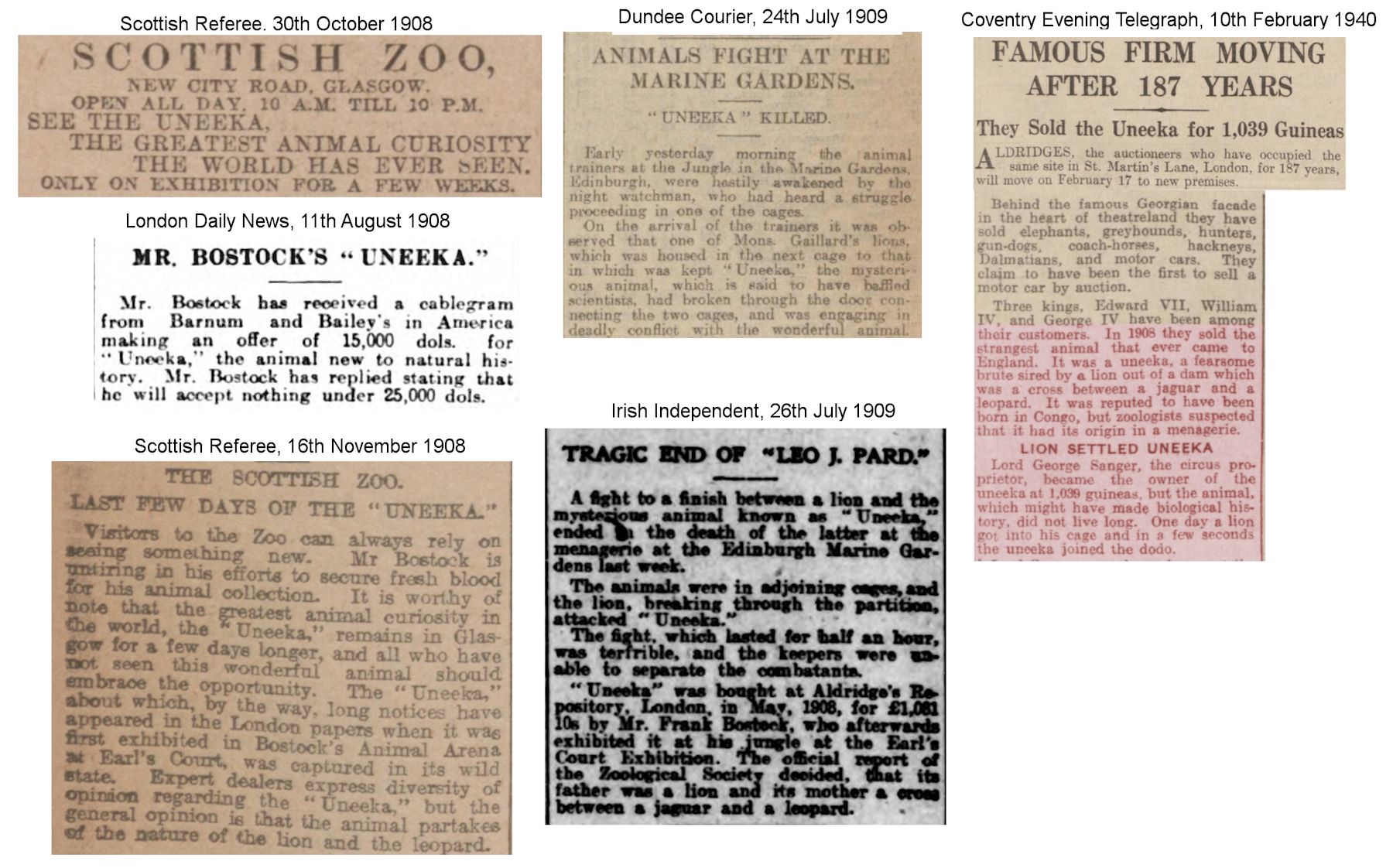
In The Field No 2889, May 9th, 1908, R I Pocock wrote of "The Supposed Lion-Leopard Hybrid" "Sir - Since you were good enough to publish in the Field of April 18 my description of the supposed lion-leopard hybrid with its history as issued to the press by Mr Hamlyn, I should like to give what I am convinced is the true sotry of its origin and antecedents, so as to lay at rest once and for all the idea that it was a natural product of the French Congo.
Some years ago, three hybrids, one male, two female, were bred in Chicago from a male jaguar and an Indian leopardess, and were bought by the proprietor of an American traveeling show of performing animals. The male was killed by a lion, but the females lived, grw to the size of a jaguar, and when adult were mated with a young lion, choosing him, it is said, in preference to male leopards. Several litters were born, each consisting of two cubs. These resembled a lion in general colour, but were spotted. In the case of every litter the spots of one cub were like those of the jaguar, and the otherlike those of a leopard. The males were without mane. At the end of last year, some of these animals, then about three and a half years old, were alive in the United States.
These facts I can vouch for on first hand authority. My conviction that the animal recently exhibited in the Zoological Gardens is one of those hybrids with jaguar-like spots is a conclusion deduced from a combination of circumstances, partly from a knowledge of the recent importation by Mr Bostock from America of a number of animals for the exhibition at Earl's Court, partly from a clue supplied to me by Mr Carl Hagenbeck, who predicted almost to the letter the outcome of the sale, partly from overheard remarks let drop at the auction at Aldridge's, and finally from the fact that the animal was knocked down to Mr Bostock for a sum representing ten times its market value. With the above-mentioned facts before them, your readers will be able to piece in the details of the entire transaction without further comment on my part. From a scientific standpoint the animal gains interest from a knowledge of its true nature. Not suspecting three species to be involved in its parentage, I was not quite right in determining it as a lion-leopard hybrid, although the spots, as I stated, obviously recall those of a jaguar, I dismissed that species in considering its pedigree on account of its comparatively slender build and the great length of the tail. He elimination of the shortness of the tail and of the sturdiness in shape of the jaguar is not surprising, however, seeing that these characters are only found in one out of the three parent forms. A further point of interest to be noted in this. The extreme closeness of the affinity between leopards and jaguars, which has already been claimed on other grounds, is further attested by their hybrids forming fertile unions with a species quite distinct from either of the parents. I learn from Mr hagenbeck that lion-tiger hybrids appear to be sterile, not only when paired with one another, but also when mated with the parent species. At all events one of his female hybrids produced no cubs after being mated with a male lion." (In this Pocock was incorrect as it was subsequently found that female ligers and female tigons can produce young when mated to a male tiger or lion.)
The Charlotte Observer of October 20, 1908 tells us that the triple hybrid was in the possession of Col Ferari and formed part of his wild animals show. It also appears to have had a very bad temperament. WILD ANIMAL SHOW. Visitors to the Fair have a treat in store in Col. Francis Ferari’s trained wild animals show. [. . . ] Probably the most interesting animal of them all is Colonel Ferari’s well-known hybrid, which is a combination of lion. Jaguar, and leopard, and is the only one ever produced, being a ferocious beast and one that can hardly be handled.
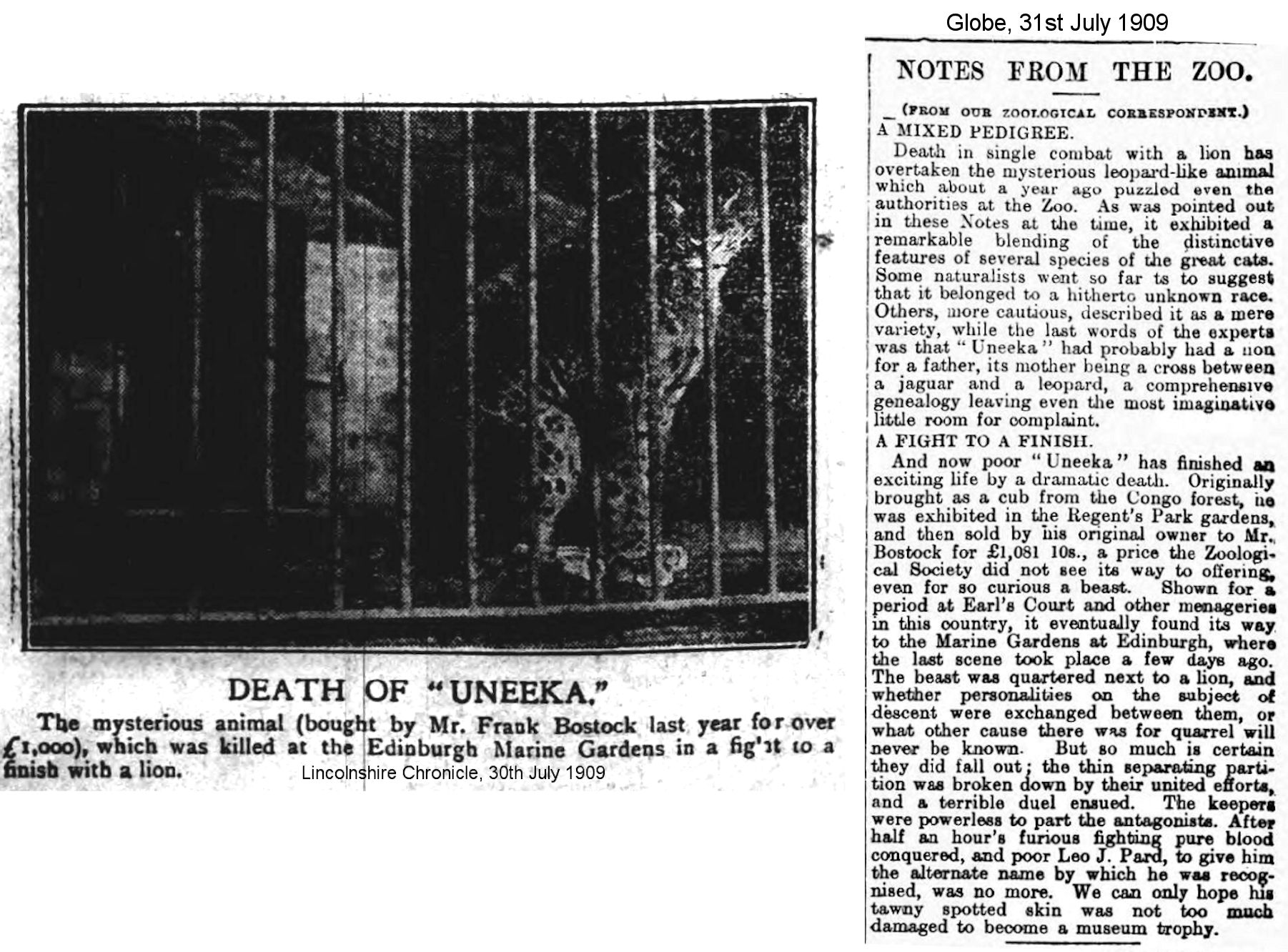
News of the demise of the hybrid was cabled from Edinburgh to many newspapers in August 1909: “UNEEKA KILLED IN BATTLE WITH LION DESPITE GUARDS. Hybrid Beast, Part Jaguar and Part leopard, No Match for King of Edinburgh Menagerie. Special Cable Dispatch to The Inter Ocean. EDINBURGH. Aug. 7 [1909].—The curious hybrid animal known is Uneeka, which was bought at Aldridge’s in Mar. 1908 by Mr. Bostock for 1,030 guineas, ;was killed yesterday in a light with a lion at Edinburgh marine gardens. The animals shared adjoining cages, and the lion broke through the connecting door, and, after a terrible struggle lasting about half an hour, during which the trainers made unsuccessful attempts to separate the animals, the lion overcame its antagonist. Uneeka, according to the official description of the Zoological society, to which it was intrusted before being sold last year, was a double hybrid. Its father was a lion; its mother a hybrid between a jaguar and a leopard. It was supposed to come from the Congo, but the zoologlcal officials were inclined to believe that it was bred in a menagerie.” (Jaguars are not found in the Congo, of course.)
The fate of the "Congolese Spotted Lion" (the lijagulep exhibited in Britain) is also mentioned in R I Pocock's letter to The Field of 2nd November 1912 where he compared it to the leopons born in Kolhapur (1910): "The nearest approach to [a lion-leopard] hybrid hitherto reported is the one bred at Chicago between a male lion and a female cross between a jaguar and a leopard, the true story of which, accompanied by a good figure by Mr Frohawk, may be found in the Field for April 18 and 25, and May 9, 1908. The final episode in the history of that animal has, I believe, not yet been told. After being exhibited in the Zoological Gardens and at the White City it went to Glasgow, where, according to a sensational Press notice, it was killed by a lion, which broke down the partition between the cages and made short work of its opponent. That this story was of a piece with the original account of the hybrid given out when it first appeared on the market may be inferred from the condition of the dressed skin, which had no sign of a tear or scratch upon it in London shortly after the alleged tragedy. The chief difference between this hybrid of three species and the lion-leopard born at Kolhapur lies in the size of the spots, those of the [lijagulep] being large and jaguar-like, as might be expected, while those of the [leopon] are small and more leopard-like."
From Pocock's comments, the hybrids appear to have been born around 1904. There were probably at least 3 litter born with the lion siring cubs on both female lep-jags. SS Flower (1929) described London Zoo's hybrid (exhibited 1908) between a male lion and female leopard/jaguar hybrid.
LIONS AND LEOPARDS CREATE TERROR AT FAIR . FEROCIOUS ANIMALS ESCAPED FROM CAGES IN SHOW . . . BI-HYBRID IN AN ENDEAVOR TO ESCAPE SWAM ACROSS RIDEAU CANAL TO OTTAWA EAST. The Ottawa Evening Journal, 15th September 1911, pg 2.
A powerful, snarling lion, two lithe, vicious leopards, and a semi-tamed by-Hybrid [lion-leopard hybrid] fanned Into a reckless fury at the prospect of freedom, after having escaped from their cages, romping through the midway, driving; screaming women and children, scurrying before them in deathly terror, was the stirring spectacle witnessed on the Exhibition Grounds'this morning at about 10 o'clock [ . . . ] In the meantime, the Bl-Hybrid, in a desperate attempt to e cape, plunged Into the Rideau Canal and struck out for the opposite shore, attracted evidently by the cluster of trees and shrubbery on the Ottawa East side. [the leopards and lion were recaptured] The greatest difficulty was experienced in capturing the By-Hybrid. A boat was secured, and the trainer followed it across the canal. In Slattery’s field they succeeded after several attempts at lassooing it, but it was not placed in its cage before t too inflicted a painful bite on trainer Herr Herteino’s arm. [. . .] The leopards’ names are “Buster” and "Julia." while the By-Hybrid bears the title of "Goldie."
CONEY’S PETS PERISH IN FIRE. MONARCHS OF JUNGLELAND ROAST TO DEATH. MANY SHOT DOWN BY MERCIFUL TRAINERS. The Courier Journal (Louisville, Kentucky), 28th May 1911, pg 7.
New York, May 27. (Special.) A flat, black plain of about ten acres of steaming embers and twisted iron spread out before the eyes of thousands when the sun rose upon Coney Island this morning, the ruins of the fire which had started at 2 a, m. at the Dreamland concession, known as Hell Gate . . . In the ruins were the charred bodies of about eighty lions, bears, monkeys, deer. leopards and various hybrids, which had been a part of Col. Ferraris animal show. [. . . ] Col. Ferrari, Jack Bonavita and Dr. F.W. Hastings, veterinarian to the animal show, got five lionesses, six ponies, two llamas, a monkey, a great Dane and four leopards out of the building. Then as there was no time to drive the eighty or more animals into transfer boxes, Capt. Bonavita ran from cage to cage shooting the trained wild animals through the head until he could stand the heat and smoke no longer. [. . .] so long did Bonavita stay in the burning arena that he saw part of the roof at the ocean side of the structure fall upon the cages of the monkeys and hybrids - half-lion. half-jaguar - and bury the animals, which by this time probably were dead. [. . .] In their cages in the meantime seven lions, two leopards, a small bear, three pumas, four hybrids . . . had been burned to death. (This means there were at least 4 hybrids, some of which were lion-jaguar hybrids. This was the old Bostock arena. It was the third big fire in 4 years.)
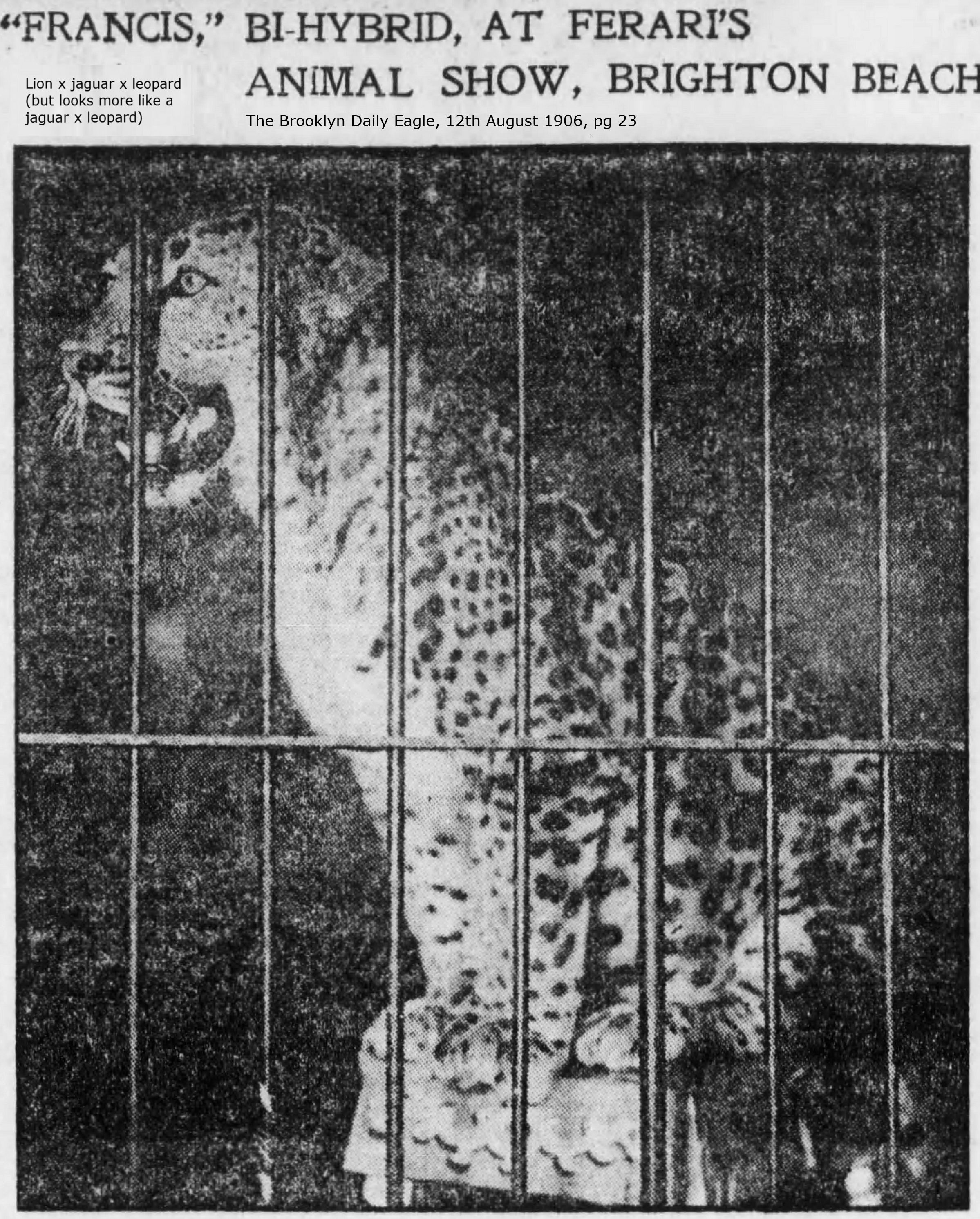
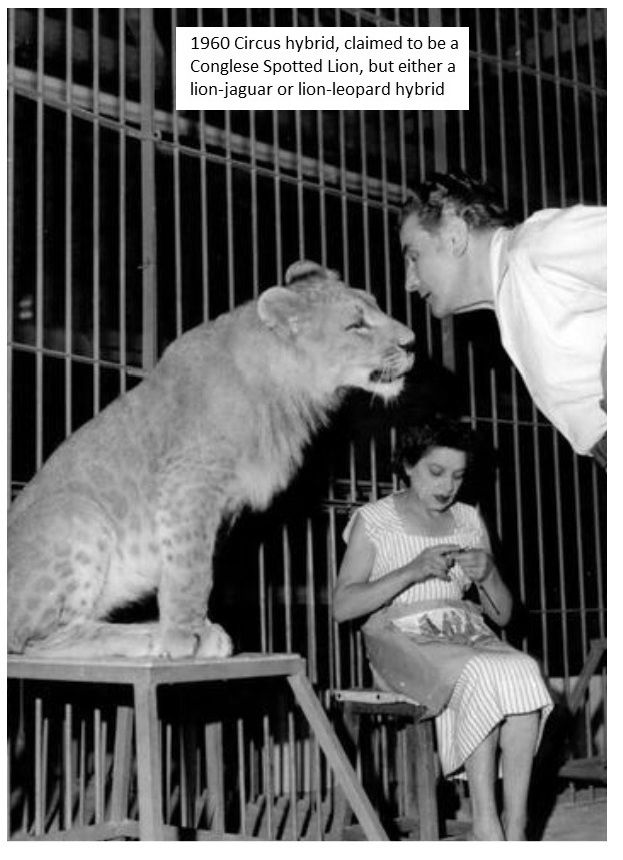
BLACK JAGLIONS
Black jaguars (black panthers) have always caught the public imagination. The gene for melanism in jaguars is incompletely dominant hence "black" jaglions, having only one copy of the gene, are charcoal grey rather than glossy black.
INTRA-SPECIFIC JAGUAR HYBRIDS
Panthera onca onca x P o palustris – 3 male hybrids born Brasilia, Brazil in 1966. International Zoo Yearbook (1968)
REFERENCES AND FURTHER READING
Historical accounts (chronological order): R De Davison (1863), Sacc (1863), A Rörig (1903 – quotes Sacc), H Scherren (1908), SS Flower (1929), O Antonius (1951), H Petzsch (1956), H Hemmer (1966, 1968), H Windischbauer (1968), C Pohle (1969).
Helmut Hemmer: "Report on a Hybrid Between Lion x Jaguar x Leopard - Panthera leo x Panthera onca x Panthera pardus" in Saeugetierkundliche-Mitteilungen, 1968; 16(2): 179-182.
Howell, Mary-Anne: Personal Correspondence 2006/7
G Peters included several hybrids (liger, tigon, leopon, leguar) in his "Comparative Investigation of Vocalisation in Several Felids" published in German in Spixiana-Supplement, 1978; (1): 1-206.
Pocock, R.I. 1908 "Hybrid Lion and Leopard
The Times for Monday May 4, 1908 pg. 12
The Times (April 15, 1908) pg. 6
Textual content is licensed under the GFDL.
Many thanks to Paul McCarthy for tirelessly researching back issues of The Field and The Times to unravel the case of the Congolese Spotted Lion. .
|
BACK TO HYBRID & MUTANT BIG CATS INDEX |